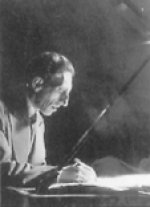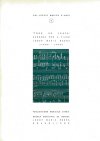
Josep Maria Ruera i Pinart was born in Barcelona on August 2, 1900 and at age 9 he moved to Granollers, where he lived until his death on May 31, 1988. After a first phase as a student in Granollers in the Escuela Municipal de Música (Municipal Music School) of Barcelona and in the Lyceum Conservatory, the City Hall of Granollers awarded him a grant in 1917. He used it to study composition with Enric Morera and orchestration with Joan Baptista Lambert and Joan Lamonte de Grignon, with whom he kept in contact throughout his musical career and of whom he himself said: 'he was, musically speaking, like a real father to me'.
He was a violist with the Orquesta Pau Casals during the cycle of concerts of Primavera de Gran Teatro del Liceo in the year 1923. He conducted some instrumental and choir ensembles such as the Selección orchestra, the Schola Cantorum and the Orfeó Femení de Granollers. At the same time, he was director of the Escuela Municipal de Granollers (a school which bears his name today) and organist in the Iglesia Parroquial de San Esteban.
During his whole career as a composer, he earned several important awards and accolades. He won the first prize in the contest held by the group Joventut Hotelera de Barcelona because of the Universal Exposition event (1929). He also won the Premi Pau Casals, in the Jocs Florals de la Llengua Catalana held in Paris (1959) and the prize Ciudad de Barcelona (in the years 1970 and 1971).
Two things marked forever his musical career. The first being the debut - thanks to the council his maestro and friend Joan Lamote de Grignon had given him - of his work Tres Moviments Simfònics during the XIV Festival de la Sociedad Internacional de Música Contemporánea (SIMC) held in Barcelona in 1936. The second being the debut and later the recording of his four symphonic poems grouped under the title of Empúries. His work is divided in two different phases: one before and one after the Spanish Civil War. By looking at it, one can see a composer of the so-called Generación del 27, of the so-called 'menores'. This name is not because of the quality of his work, but because of the quantity and later influence of it, with his own style, a product of his love for the Catalan folklore and with very pronounced nationalist features ' all within the neo-romantic traditional tone context.










